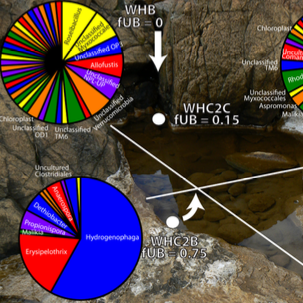Link to online paper: https://journals.asm.org/doi/10.1128/AEM.00330-13
Abstract
ABSTRACT Reactions associated with the geochemical process of serpentinization can generate copious quantities of hydrogen and low-molecular-weight organic carbon compounds, which may provide energy and nutrients to sustain subsurface microbial communities independently of the photosynthetically supported surface biosphere. Previous microbial ecology studies have tested this hypothesis in deep sea hydrothermal vents, such as the Lost City hydrothermal field. This study applied similar methods, including molecular fingerprinting and tag sequencing of the 16S rRNA gene, to ultrabasic continental springs emanating from serpentinizing ultramafic rocks. These molecular surveys were linked with geochemical measurements of the fluids in an interdisciplinary approach designed to distinguish potential subsurface organisms from those derived from surface habitats. The betaproteobacterial genus Hydrogenophaga was identified as a likely inhabitant of transition zones where hydrogen-enriched subsurface fluids mix with oxygenated surface water. The Firmicutes genus Erysipelothrix was most strongly correlated with geochemical factors indicative of subsurface fluids and was identified as the most likely inhabitant of a serpentinization-powered subsurface biosphere. Both of these taxa have been identified in multiple hydrogen-enriched subsurface habitats worldwide, and the results of this study contribute to an emerging biogeographic pattern in which Betaproteobacteria occur in near-surface mixing zones and Firmicutes are present in deeper, anoxic subsurface habitats.
